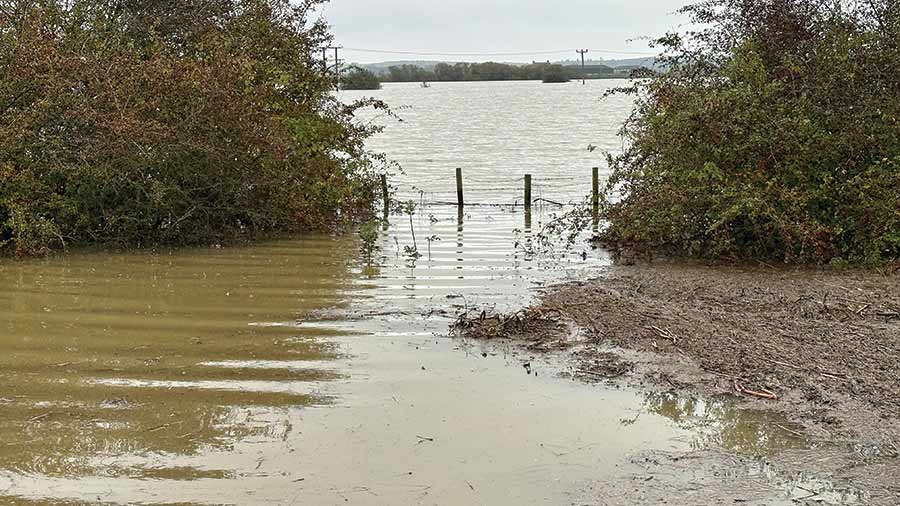How Flooding Impacts Livestock And Farm Operations

Table of Contents
Flooding is a devastating natural disaster that inflicts significant damage on agricultural lands worldwide. The devastating impact of flooding on livestock and farms is often underestimated, resulting in substantial economic losses and long-term consequences for farmers and the food supply. This article explores the various ways flooding impacts livestock and farms, examining both the immediate and long-term effects of this natural disaster. We will delve into the direct impacts on livestock, the damage to farm operations and infrastructure, and the significant financial and economic consequences of flooding.
<h2>Direct Impacts of Flooding on Livestock</h2>
Flooding poses an immediate and significant threat to livestock. The direct impacts can be devastating, leading to substantial losses and long-term health problems for surviving animals.
<h3>Drowning and Injury</h3>
The most immediate danger is drowning. Flash floods, in particular, can quickly overwhelm animals, leading to drowning, especially among younger, less mobile animals such as calves, lambs, and piglets. Even if animals survive, they may sustain serious injuries, such as:
- Broken limbs
- Hypothermia
- Lacerations
- Internal injuries
The loss of young animals can have a significant impact on future herd productivity and profitability. Statistics show that a single flood event can result in the loss of hundreds or even thousands of livestock depending on the severity and location of the flood.
<h3>Disease and Parasite Outbreaks</h3>
Floodwaters often carry pathogens and parasites, creating a breeding ground for disease outbreaks. Contaminated water sources can lead to several health issues, including:
- Waterborne diseases like leptospirosis and salmonellosis
- Increased parasite infestations such as worms and ticks
- Contamination of feed and drinking water sources
Post-flood, disease prevention and control are challenging. The displacement of animals and the damage to infrastructure can hinder the implementation of effective biosecurity measures, leading to further spread of disease and prolonged health problems for the affected livestock.
<h3>Loss of Pasture and Feed Sources</h3>
Flooding can completely destroy pastures and stored feed, leaving livestock without adequate nutrition. This includes:
- Submerged pastures rendering them unusable for grazing for extended periods.
- Spoiled hay and silage due to water damage and mold growth.
- Disruption of feed supply chains, making it difficult for farmers to source replacement feed.
The lack of sufficient and nutritious feed leads to weight loss, reduced milk production, and increased susceptibility to disease. This impacts the overall health and productivity of the animals, potentially causing long-term consequences for farm profitability.
<h2>Impacts on Farm Operations and Infrastructure</h2>
The impact of flooding extends far beyond the immediate effects on livestock. Farm operations and infrastructure suffer extensive damage, hindering productivity and adding to economic losses.
<h3>Damage to Farm Buildings and Equipment</h3>
Floodwaters can cause significant damage to farm buildings and equipment, creating substantial repair costs. This includes damage to:
- Barns and stables
- Silos and storage facilities
- Fencing
- Farm machinery (tractors, harvesters, etc.)
- Irrigation systems
The cost of repairing or replacing damaged infrastructure can be immense, putting a significant financial strain on farmers. In many cases, the damage is so extensive that farms become inoperable for extended periods.
<h3>Disruption of Farm Activities</h3>
Flooding disrupts daily farm operations, creating significant delays and losses in productivity. This can include:
- Inability to access fields for planting, harvesting, or livestock management.
- Delays in planting and harvesting, leading to reduced yields.
- Disruption of milk production due to power outages or damage to milking facilities.
- Challenges in transporting livestock to markets or other locations.
These disruptions have significant economic consequences, leading to reduced income and potentially long-term financial instability for farmers.
<h3>Soil Degradation and Loss of Productivity</h3>
The long-term effects of flooding include soil degradation, significantly impacting future farming productivity. Flooding can result in:
- Soil erosion, washing away topsoil and vital nutrients.
- Nutrient loss, reducing soil fertility and impacting crop yields.
- Increased soil salinity, further reducing crop productivity.
- Changes in soil structure, making it difficult for crops to establish and thrive.
Remediating flood-damaged soil requires time, effort, and resources. The long-term impact on soil health can significantly reduce yields and profitability for years to come.
<h2>Financial and Economic Consequences</h2>
The financial and economic consequences of flooding on livestock and farms are far-reaching and devastating. Farmers face immense challenges in recovering from these losses.
<h3>Insurance and Compensation</h3>
Insurance plays a crucial role in mitigating financial losses, but obtaining adequate coverage and compensation can be difficult. Farmers need to consider:
- Types of insurance coverage available for livestock, crops, and infrastructure.
- Application processes and claim procedures, which can be complex and time-consuming.
- Government assistance programs designed to support farmers recovering from natural disasters.
Often, the compensation received does not fully cover the actual losses suffered, leaving farmers with significant financial burdens.
<h3>Loss of Income and Market Disruptions</h3>
Flooding directly impacts farmers' income through decreased production and market disruptions. This includes:
- Reduced livestock sales due to loss of animals or decreased productivity.
- Inability to meet market demands due to production delays or crop failures.
- Increased input costs for repairing damage, replacing lost inventory, and purchasing new feed.
- Potential for bankruptcy due to the accumulation of debt and financial losses.
Farmers need to develop strategies to mitigate economic losses, including diversification of income sources and robust financial planning.
<h2>Conclusion</h2>
The flooding impact on livestock and farms is severe and multifaceted. From the immediate loss of livestock and damage to infrastructure to long-term soil degradation and economic hardship, the effects are devastating and far-reaching. Understanding these impacts is crucial for developing effective flood preparedness and mitigation strategies. Learn more about flood preparedness and mitigation strategies for livestock and farms today! Consult your local agricultural extension service, insurance provider, or government resources to find out how to protect your operation from the devastating effects of flooding.

Featured Posts
-
 Who Wants To Be A Millionaire Easy Question Stumps Contestant See If You Can Do Better
May 07, 2025
Who Wants To Be A Millionaire Easy Question Stumps Contestant See If You Can Do Better
May 07, 2025 -
 Can The Warriors Pace Dominate The Rockets Defense
May 07, 2025
Can The Warriors Pace Dominate The Rockets Defense
May 07, 2025 -
 Kwalys Hyat Jaky Shan Hqayq Stghyr Nzrtk Ilyh
May 07, 2025
Kwalys Hyat Jaky Shan Hqayq Stghyr Nzrtk Ilyh
May 07, 2025 -
 Seattle Mariners Dominate Marlins 14 0 Victory Fueled By First Inning
May 07, 2025
Seattle Mariners Dominate Marlins 14 0 Victory Fueled By First Inning
May 07, 2025 -
 Nedug Papy Frantsiska Kto Stanet Sleduyuschim Papoy Rimskim
May 07, 2025
Nedug Papy Frantsiska Kto Stanet Sleduyuschim Papoy Rimskim
May 07, 2025
Latest Posts
-
 Pro Shares Launches Xrp Etfs No Spot Market But Price Impact
May 08, 2025
Pro Shares Launches Xrp Etfs No Spot Market But Price Impact
May 08, 2025 -
 Xrp Etf Approval A Realistic Look At Potential 800 Million Inflows
May 08, 2025
Xrp Etf Approval A Realistic Look At Potential 800 Million Inflows
May 08, 2025 -
 Xrps Future Navigating The Secs Commodity Classification
May 08, 2025
Xrps Future Navigating The Secs Commodity Classification
May 08, 2025 -
 Could Xrp Etf Approval Unleash 800 Million In First Week Investments
May 08, 2025
Could Xrp Etf Approval Unleash 800 Million In First Week Investments
May 08, 2025 -
 Grayscale Xrp Etf Filing Why Xrp Outperforms Bitcoin And Other Cryptocurrencies
May 08, 2025
Grayscale Xrp Etf Filing Why Xrp Outperforms Bitcoin And Other Cryptocurrencies
May 08, 2025
